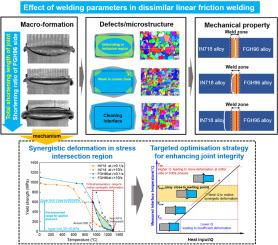International Journal of Machine Tools and Manufacture ( IF 14.0 ) Pub Date : 2023-07-19 , DOI: 10.1016/j.ijmachtools.2023.104062 Peihao Geng , Hong Ma , Mingxiang Wang , Guoliang Qin , Jun Zhou , Chunbo Zhang , Yunwu Ma , Ninshu Ma , Hidetoshi Fujii

|
Linear friction welding is a solid-state, near-net shape manufacturing method for metallic alloys which is characterised by complex deformation and metallurgical actions at the weld interface. However, a lack of understanding of the welding parameter interaction and subsequent welding mechanisms is hindering the joint integrity enhancement of dissimilar linear friction welding. In this study, we investigated the influence of various process parameters on macro/micro-formation, microstructural evolution, and properties to establish optimal welding conditions for the sound linear-friction-welded joint integrity of dissimilar superalloys, IN718, and the powder metallurgy FGH96. Increased oscillation frequency or decreased applied pressure promoted continuous dynamic recrystallisation and grain refinement, although discontinuous dynamic recrystallisation remained dominant. Enhanced dissolution of the strengthening phases (γ′ phase on the FGH96 side and δ phase on the IN718 side) was observed from the thermomechanically affected zone to the interface. The subsequent correlation between the microstructure and mechanical properties indicated that solid–solution strengthening was the dominant mechanism for enhancing interfacial bonding, which was promoted by mutual material deformation on both sides. Accordingly, to achieve synergistic plastic deformation in dissimilar linear friction welding, an optimisation strategy of welding parameter combination was proposed and validated by investigating hot compressive dissimilar Ni-based superalloys. The results of simulations of sub-size workpieces showed that using linear friction welding to manufacture bimetallic bladed disks, from conception to completion, was feasible. The paper offers an integrated solution for the full-scale manufacturing of an IN718/FGH96 blisk using linear friction welding based on microstructure–property interactions and relevant simulations, which can ideally serve as the basis for future bimetallic bladed disk manufacturing.
中文翻译:

镍基高温合金异种材料线性摩擦焊接
线性摩擦焊是一种固态、近净形的金属合金制造方法,其特点是焊接界面处存在复杂的变形和冶金作用。然而,缺乏对焊接参数相互作用和后续焊接机制的了解阻碍了异种线性摩擦焊接接头完整性的增强。在这项研究中,我们研究了各种工艺参数对宏观/微观形成、微观结构演变和性能的影响,以建立最佳焊接条件,以实现异种高温合金、IN718 和粉末冶金的良好线性摩擦焊接接头完整性。FGH96。增加振荡频率或降低施加压力促进了连续动态再结晶和晶粒细化,尽管不连续动态再结晶仍然占主导地位。从热机械影响区到界面,观察到强化相(FGH96 侧的 γ' 相和 IN718 侧的 δ 相)的增强溶解。随后的微观结构和力学性能之间的相关性表明,固溶强化是增强界面,这是通过两侧材料的相互变形来促进的。因此,实现协同塑性变形在异种材料线性摩擦焊接中,通过研究热压异种镍基高温合金,提出并验证了焊接参数组合的优化策略。小尺寸工件的模拟结果表明,使用线性摩擦焊制造双金属叶片盘,从构思到完成都是可行的。该论文提供了一种基于微观结构-性能相互作用和相关模拟的线性摩擦焊接全面制造 IN718/FGH96 整体叶盘的集成解决方案,可以理想地作为未来双金属叶片盘制造的基础。












































 京公网安备 11010802027423号
京公网安备 11010802027423号